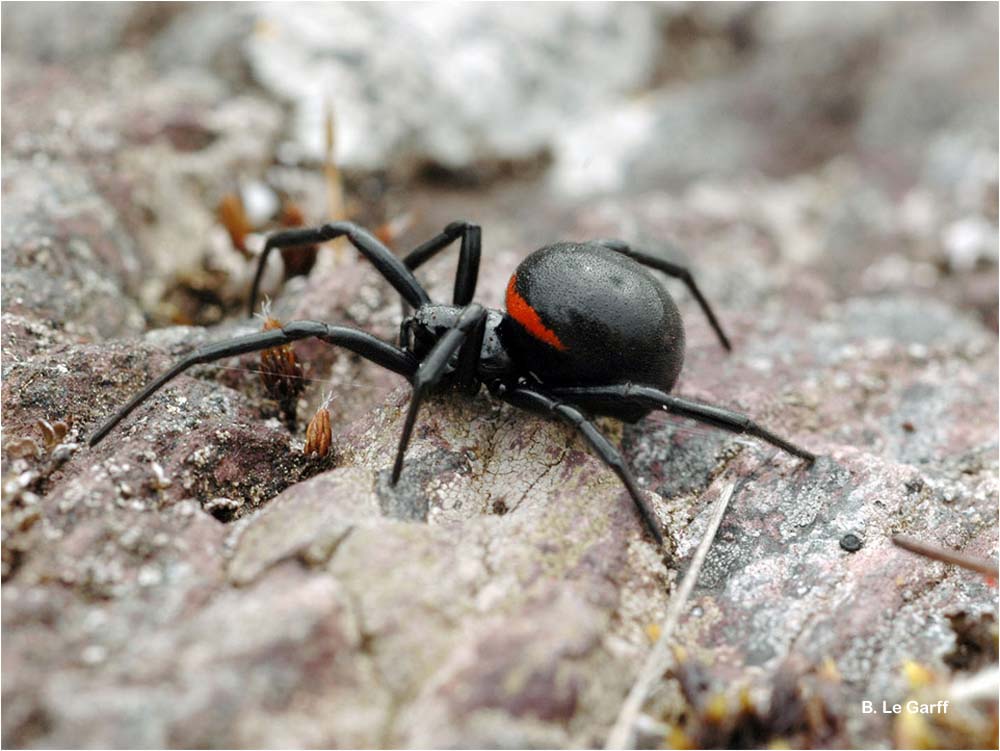
cd_nom

| Author : S. Déjean |
 |
To get the picture, please visit:
Sylvain Déjean
Biodiversité et gestion des territoires
Université de Rennes 1
SPN, Av du Gal leclerc
30042 Rennes Cedex
email: alain.canard@univ-rennes1.fr
Legend: montoulieu
Any reuse of one or more photographs on this site is subject to an authorization request from the author.
Link to the Code of Intellectual Property (Legifrance)

| Author : B. Le Garff |
 |
To get the picture, please visit:
Bernard Le Garff
Biodiversité et gestion des territoires
Université de Rennes 1
SPN , Av du Gal leclerc
30042 Rennes Cedex
Legend: femelle, Paimont
Any reuse of one or more photographs on this site is subject to an authorization request from the author.
Link to the Code of Intellectual Property (Legifrance)
Distribution mondiale
Sud de l'Europe, Bassin méditerranéen
Caractères distinctifs, espèces
Taille - femelle : 8-13 mm, mâle : 4-7 mm.
L'espèce est assez caractéristique par sa couleur noire et son corps munis de soies courtes qui la font paraître lisse. Seul son abdomen peut présenter d'autres couleurs, on voit souvent en France une tache abdominale dorsale très visible : jaune, orangé ou rouge. Il peut aussi exister sur l'abdomen une tache médiane claire aux bords sinueux. Ces couleurs d'avertissement sont liées à sa toxicité pour les vertébrés, ses prédateurs potentiels.
Milieux colonisés
L'espèce colonise des milieux chauds et secs, avec une végétation rare ou absente et présentant des trous ou fentes. Il s'agit de landes, de dunes, de rochers.
Chasse
L'espèce construit une toile constituée d'un réseau de fils solides, avec des points collants, qui s'entrelacent et divergent à partir d'un tube retraite caché dans le sol. Des terriers de Grillons champêtres sont parfois utilisés pour abriter la retraite. Les proies sont parfois très grandes et coriacées comme des grillons ou des coléoptères. L'araignée sort de sa retraite dès qu'une proie touche un des fils, englue la victime à distance dans de la soie puis la mord à une patte. Le venin fait rapidement son effet. L'araignée se retire ensuite avec sa proie dans la retraite.
Développement, cycle
Les femelles sont présentes une grande partie de l'année, les mâles seulement au printemps. Le cycle est annuel. Les mâles sont précoces, en mars-avril, puis disparaissent rapidement après une courte période de reproduction. Les femelles pondent dans leur tube retraite plusieurs cocons sphériques blancs. Ils comprennent une centaine d'œufs, enveloppés dans une soie floconneuse, chacun d'eux paraissant aussi grand que la femelle. L'espèce est aussi venimeuse pour ses prédateurs potentiels. En laboratoire, son venin peut tuer un rat et paralyse un lapin pendant quelques minutes.
A. Canard(Université de Rennes/Service du Patrimoine Naturel, MNHN),2014
Continental
Metropolitan France
Overseas
Marine
Metropolitan France
Overseas
The map presents a summary at the 10 x 10 km grid of the observation data for the species transmitted to the SINP. These data have been subjected to validation filters.
The map presents a reference distribution layer of the species at the scale of departments and marine sectors. The presence and absence data were established by expertise within a network of partners. This reference distribution is used in the validation process of the SINP data at the INPN level.
Corresponds to a report on the basis of at least one observation proved within a period of 10 years (20 years for little-known invertebrates) preceding the year and no presumption of extinction since obtaining the last data nor doubt on reproductive and implemented nature of this population. For migratory species, the presence indicated concerns areas of reproduction.
This status is based on one or more of the following criteria:
This point covers the absence, more difficult by nature to demonstrate than presence. This status is based on one or more of the following criteria:
This status must be assigned to a department in which the presence of the species is casual.
Particular case of absence due to a proven extinction less than a half century ago (older disappearances are treated as "no probable or definite").
In the state of knowledge, we can not comment on the presence or absence in the current department. This is the default status when not comprised in one of the previous categories or whenever there is doubt.
The map shows the global distribution of the species based on GBIF data (Global Biodiversity Information Facility).
